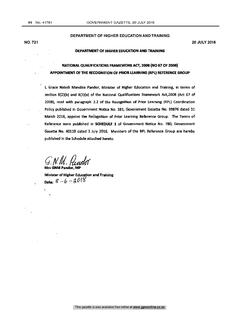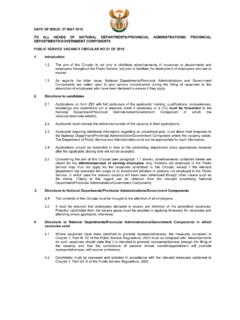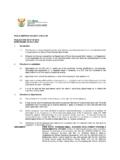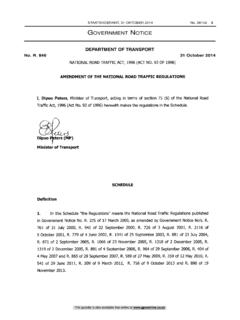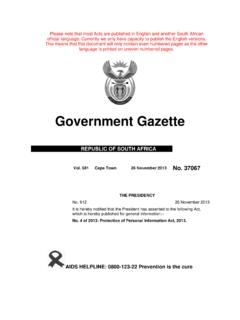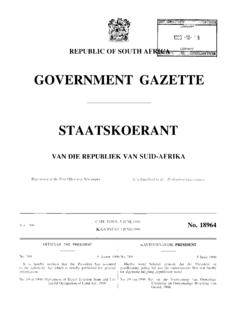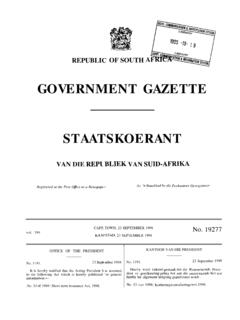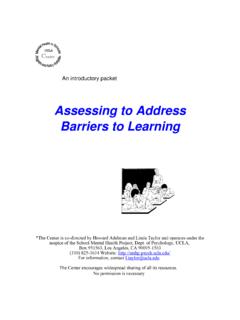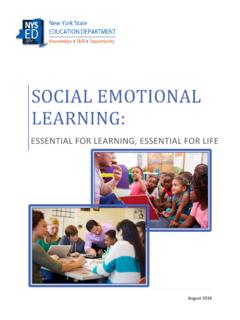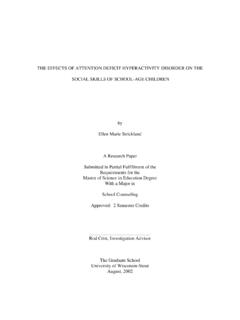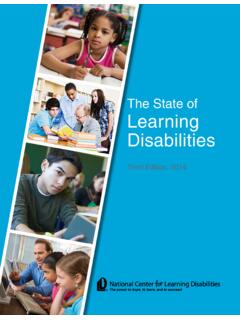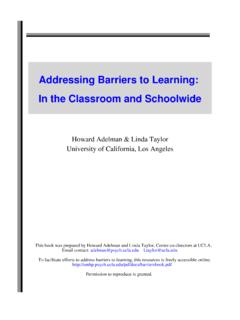Transcription of Policy on screening, identification, assessment and ...
1 DRAFT Policy ON SCREENING, IDENTIFICATION, assessment AND SUPPORT 2014 2 Department of Basic Education Sol Plaatje House 222 Struben Street Private Bag X895 Pretoria 0001 South Africa Tel: +27 12 357 3000 Fax: +27 12 323-0601 120 Plein Street Private Bag X9023 Cape Town 8000 South Africa Tel: +27 21 465-1701 Fax: +27 21 461-8110 Department of Basic Education 3 CONTENTS ACRONYMS AND ABREVIATIONS vi DEFINITIONS vii CHAPTER 1: INTRODUCTION TO THE Policy ON SCREENING, IDENTIFICATION, assessment AND SUPPORT 1.
2 PURPOSE OF THE Policy 2. RELATED LEGISLATION AND POLICIES CHAPTER 2: RATIONALE OF THE Policy 1. DETERMINING THE SUPPORT NEEDS OF ALL LEARNERS 2. ADDRESSING BARRIERS TO learning AND DEVELOPMENT 3. IMPLEMENTATION OF THE Policy IN THE SHORT TERM CHAPTER 3: PRINCIPLES OF THE Policy 1. ORGANISING PRINCIPLES 2. PRINCIPLES OF SUPPORT 3. PRINCIPLES OF assessment 4. GUIDING PRINCIPLES OF DECISION MAKING 5. COMPETENCIES RELATED TO THE SIAS PROCESS CHAPTER 4: LEVEL AND nature OF SUPPORT 1. SHIFTING FOCUS FROM THE INDIVIDUAL LEARNER TO THE SUPPORT PROGRAMME 2.
3 INSTITUTIONAL ARRANGEMENTS FOR DELIVERY OF SUPPORT 3. ADDRESSING BARRIERS TO learning 4. PROGRAMMES OF SPECIALISED SUPPORT 5. DESCRIPTORS TO DETERMINE LEVEL AND nature OF SUPPORT PROVISION 6. RATIONALE FOR MOVING FROM CATEGORY OF DISABILITY TO DETERMINING THE LEVEL AND nature OF SUPPORT CHAPTER 5: INSTITUTIONAL ARRANGEMENTS 1. INTEGRATED COMMUNITY-BASED SUPPORT PROVISIONING 2. ALIGNMENT TO THE SYSTEMS AND POLICIES WITHIN BASIC AND HIGHER EDUCATION 4 3. ALIGNMENT TO THE INCLUSIVE EDUCATION Policy 4.
4 NORMS AND STANDARDS 5. ALIGNMENT TO HEALTH SYSTEMS 6. ALIGNMENT TO SOCIAL SERVICES CHAPTER 6: THE STAGES OF THE PROCESS OF SCREENING, IDENTIFICATION, assessment AND SUPPORT (SIAS) 1. SUMMARY OF THE STAGES OF THE SIAS 2. MAIN PURPOSE OF THE PROCESS CHAPTER 7: ROLE FUNCTIONS AND RESPONSIBILITIES 1. ROLE FUNCTIONS OF SCHOOL STAKEHOLDERS 2. FUNCTIONS OF THE SCHOOL-BASED SUPPORT TEAMS 3. COMPOSITION OF SCHOOL-BASED SUPPORT TEAMS 4. ROLE OF THE SCHOOL-BASED SUPPORT TEAM IN THE SIAS PROCESS 5.
5 EXTERNAL SOURCES OF SUPPORT 6. DEPARTMENT OF HEALTH SERVICES AND HEALTH CARE PRACTITIONERS 7. DEPARTMENT OF SOCIAL DEVELOPMENT AND SOCIAL WORKERS 8. NON-GOVERNMENTAL ORGANISATIONS, DISABLED PEOPLE ORGANISATIONS AND HIGHER EDUCATION INSTITUTIONS 9. ECD SERVICE PROVIDERS 10. THE ROLE OF TEACHERS AND PRACTITIONERS 11. THE ROLE OF DISTRICT-BASED SUPPORT TEAMS 12. THE ROLE OF PARENTS/ CAREGIVERS 13. THE ROLE OF LEARNERS 14. APPEAL BY PARENTS FORMS LEARNER PROFILE SNA 1: TEACHER assessment AND INTERVENTION Areas of concern Teacher interventions\support SNA 2: assessment OF SUPPORT NEEDS AND INTERVENTION BY SCHOOL-BASED SUPPORT TEAM (SBST) / INSTITUTION-LEVEL SUPPORT TEAM (ILST) SBST: Plan of Action SBST: Request for assistance from the District Based Support Team (DBST) SNA 3: DISTRICT-BASED SUPPORT TEAM (DBST) INTERVENTION 5 DBST: Guidelines for Support DBST: Table to rate level of support DBST.
6 Checklist to help determine the decision on support to be provided to the learner. DBST: Plan of Action in relation to the learner DBST: Plan of Action in relation to the school ANNEXURES ANNEXURE A1: Request by parent \legal caregiver for placement\ transfer of learner to a resource centre\ special school to access a high level specialist support programme ANNEXURE A2: Application by the District Based Support Team for placement of learner ANNEXURE B: Application by the SBST\DBST for a Concession, Exemption or Endorsed NSC ANNEXURE C: Curriculum Differentiation Schedule ANNEXURE D.
7 Health and Disability assessment Form 6 ACRONYMS AND ABBREVIATIONS AAC Alternative and Augmentative Communication ABET Adult Basic Education and Training DBST District-based Support Teams DPO Disabled People Organisation DSD Department of Social Development ECD Early Childhood Development EMIS Education Management Information Systems FET Further Education and Training FSS Full-Service School GET General Education and Training SBST / ILST School-based Support Team (= SBST) / Institution-level Support Team (=ILST) ISP Individual Support Plan NCS National Curriculum Statement (Schools Grade R 12) NGO Non-governmental Organisation NPO Non-profit organisation OSDP Office on the Status of Disabled People SAPS South African Police Service SASA South African Schools Act (Act 79 of 1996)
8 SASL South African Sign Language SBST Site/school-based Support Team SGB School Governing Body SIAS Screening, Identification, assessment and Support SMT School Management Team SNA Support Needs assessment SSRC Special School Resource Centre 7 DEFINITIONS Additional Support Needs Every learner needs support, but some may, for whatever reason, require additional support for learning . Additional support needs can arise from any factor which causes a barrier to learning , whether that factor relates to social, emotional, cognitive, linguistic, disability, or family and care circumstances.
9 For instance, additional support may be required for a child or young person who has learning difficulties, is being bullied; has behavioural difficulties; is a parent; has a sensory or mobility impairment; is at risk of school drop-out or is bereaved. There will be many other examples besides these. Some additional support needs will be long term while others will be short term. The effect they have will vary from child to child. In all cases though, it is how these factors impact on the individual child s learning that is important and this will determine the level of support provision required.
10 Augmentative and Alternative Communication (AAC) AAC strategies describe the way people supplement their communication when they cannot speak clearly enough to be understood by those around them. These strategies include a wide range of communication methods ranging from gestures and communication boards to assistive communication devices. Barriers to learning Refer to difficulties that arise within the education system as a whole, the learning site and/or within the learner him/herself which prevent access to learning and development for learners.
